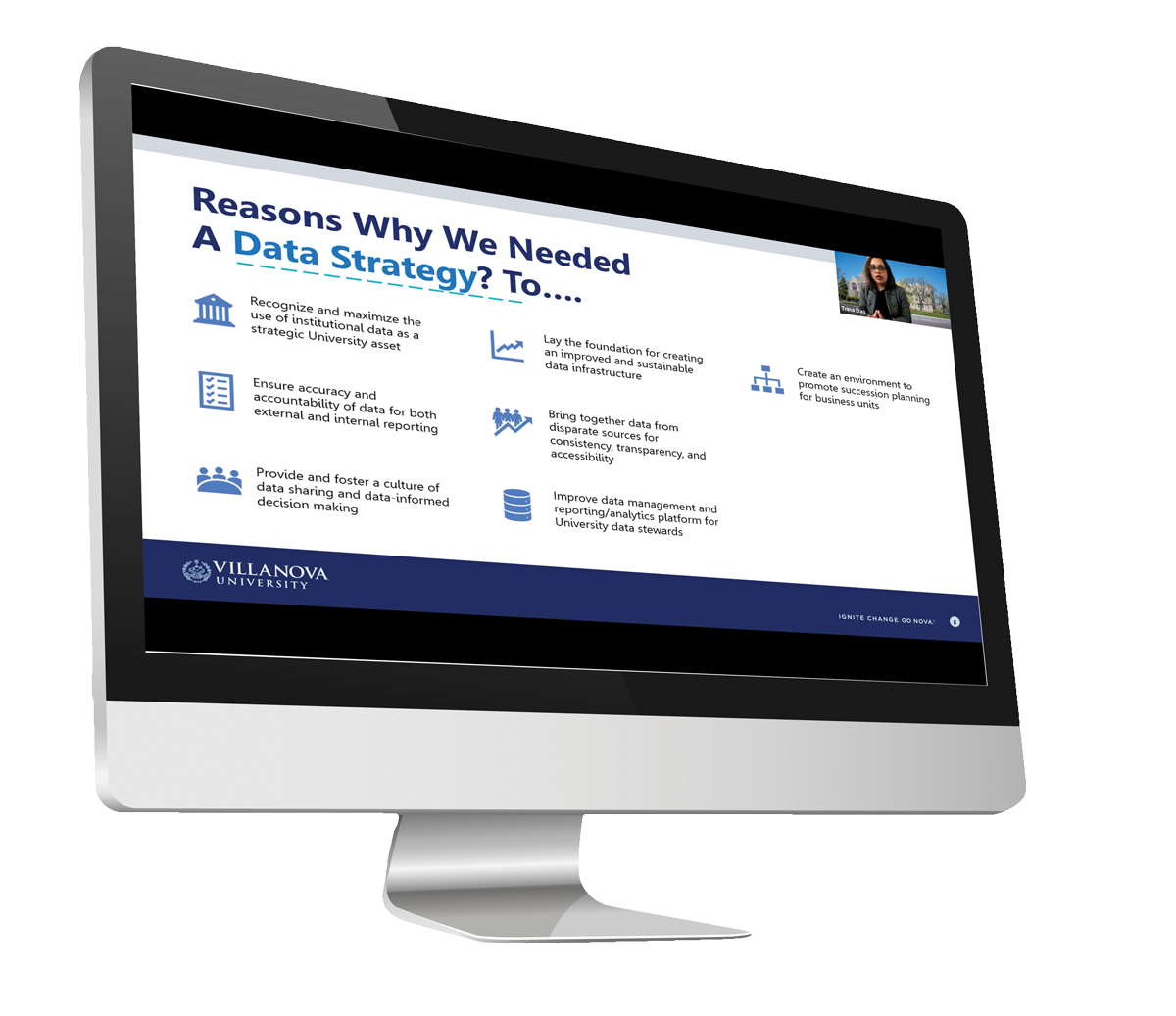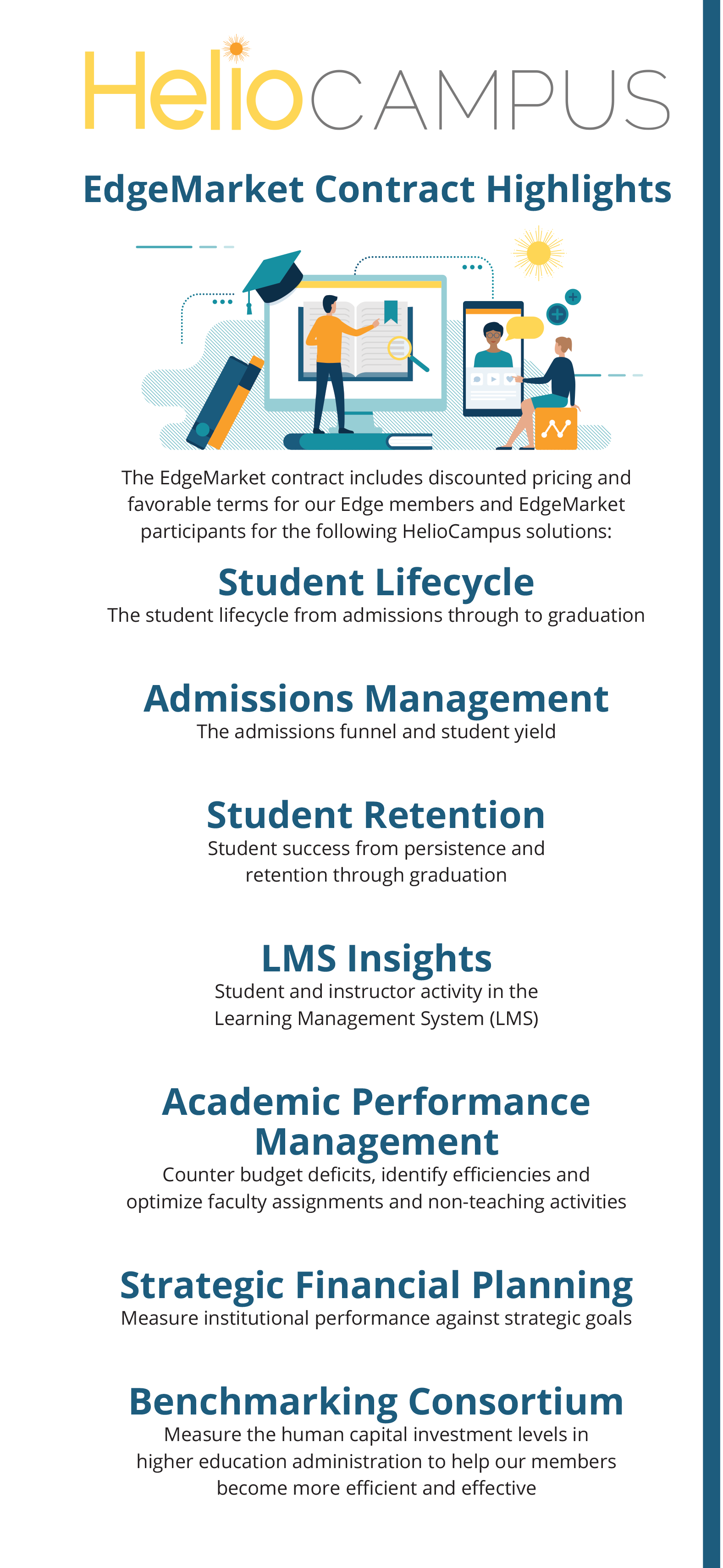 Faced with a number of barriers to data access and use, Villanova University knew that change was required in order to meet the data and analytics goals included in their updated strategic plan. Villanova had multiple source systems and tools, siloed data, no university-wide data warehouse, and a focus on operational reporting. With the goal of developing a foundation for an improved data infrastructure, data governance and creating a culture of data-informed decision making, Villanova needed a plan and a partner. However, even once key issues were identified and a plan was in place, COVID would upend and delay progress on their initiative.
Faced with a number of barriers to data access and use, Villanova University knew that change was required in order to meet the data and analytics goals included in their updated strategic plan. Villanova had multiple source systems and tools, siloed data, no university-wide data warehouse, and a focus on operational reporting. With the goal of developing a foundation for an improved data infrastructure, data governance and creating a culture of data-informed decision making, Villanova needed a plan and a partner. However, even once key issues were identified and a plan was in place, COVID would upend and delay progress on their initiative.
Several triggers led to the launch of Villanova’s data journey, including frustration among business users, college deans, senior administrators, and the provost in getting accurate data and information in a timely manner for decision making. “Data stewards who were working with the data and pulling information from other source systems were dissatisfied with the tools that were available to generate reports,” explains Dr. Trina Das, Assistant Vice Provost, Office of Decision Support and Data Integrity, Villanova University. “Some were old, decommissioned tools that were not well supported. The newer tools lacked training resources and support, and none of them gained traction in usability for the data stewards. More recently, there was heightened concern among our leadership around data accuracy, especially in relation to the external agencies, including iPads, accreditation bodies, and ranking agencies, and providing vetted, peer-reviewed data.”
Prior to COVID, Villanova was completing their strategic plan and moving on to the next phase of planning. During these discussions, the main focus was the enhanced use of technology, data, and analytics to support decision making. “There was awareness and push from many directions to address these issues and these conversations led to a five-phased Villanova strategy,” shares Das. “The strategy begins with a planning and discovery phase, which allows for an assessment of our current data landscape, including identifying our challenges and what is working and what is not in the process. From this, we created a roadmap which outlined the most relevant and immediate need for the University. This led to the discussion for our data platform and governance initiative and then ultimately, the concept of change management, which we are embarking upon this year.”
Gathering Insight
In the spring of 2019, the Office of the Provost reached out to Das, asking her to participate in a 6-month exploratory project, partnered with one of her colleagues in enrollment management. The project conducted an internal scoping of the data landscape at Villanova, specifically exploring the challenges, risks, opportunities, and recommended next steps for the process. “The goal was to provide recommendations for developing the foundation for improved data infrastructure and governance, a culture of data-informed decision making, and an operational framework that would be best suited for the University,” says Das. “We had two paths of exploration. One was our internal constituents, where we spoke to data people within every business area and college at Villanova to better understand the key issues they face. We also looked at our peer institution and other institutions to create a list of fifteen organizations that were ahead of us in this data journey and could provide a positive example for how we could move toward the future.”
 Through this investigation, Villanova was able to gather several useful insights and identify the key issues that need to be addressed. “At the time, data operations was extremely decentralized,” explains Das. “We have so many source systems feeding data and have multiple reporting tools, which creates challenges for choosing which one to use, what’s the training, and who to ask. Plus, we faced data access and sharing challenges. Due to the decentralized nature of our operations, every business area handled their own data, and without interconnectedness, the crosspollination of data was not exactly happening. This setup leaves room for operational inefficiencies and inconsistencies and we had challenges replicating information. For example, looking at the whole student’s societal life cycle, the person starts as an applicant, then graduates and becomes an alumnus. We want to know if they’re donating; what is the profile of those donors? All of this information was in different systems. We wished to create a process that would make this exercise more efficient and seamless, so that we spend more time analyzing the data, instead of collecting and merging that information.”
Through this investigation, Villanova was able to gather several useful insights and identify the key issues that need to be addressed. “At the time, data operations was extremely decentralized,” explains Das. “We have so many source systems feeding data and have multiple reporting tools, which creates challenges for choosing which one to use, what’s the training, and who to ask. Plus, we faced data access and sharing challenges. Due to the decentralized nature of our operations, every business area handled their own data, and without interconnectedness, the crosspollination of data was not exactly happening. This setup leaves room for operational inefficiencies and inconsistencies and we had challenges replicating information. For example, looking at the whole student’s societal life cycle, the person starts as an applicant, then graduates and becomes an alumnus. We want to know if they’re donating; what is the profile of those donors? All of this information was in different systems. We wished to create a process that would make this exercise more efficient and seamless, so that we spend more time analyzing the data, instead of collecting and merging that information.”
Like Villanova, many institutions across the industry struggle with the lack of proper documentation and data definitions and lineage. “We are trying to improve process documentation and ensure that if someone leaves the University or changes roles, their knowledge does not depart with them,” explains Das. “Lastly, we looked to create a single source of truth, or a place where there are data snapshots and you can replicate information. All of these key issues led to the main pillars of our data strategy and how we can better recognize and maximize the use of institutional data as a strategic University asset.”
Creating a Strategy
Upon reviewing the key issues and data challenges facing the institution, Villanova recognized the importance of a data strategy that would help them overcome the hurdles and make more informed decisions for the entire university. “We knew we must lay the foundation for creating an improved and sustainable data infrastructure,” says Das. “A central data environment would help reduce our vulnerabilities, improve our operational efficiencies, and ensure accuracy and accountability for data for internal and external reporting. The platform would bring together data from disparate sources for consistency, transparency, and accessibility. We look to foster a culture of data sharing and data-informed decision making, and Villanova continues to make great progress in this area.”
On the operational side, one of Villanova’s goals includes improving data management and the reporting and analytics platform for University data stewards. “What we are building must not only serve one purpose, but multiple purposes,” explains Das. “The infrastructure must not only meet analytical needs, but allow for some operational needs as well. We also look to create an environment that promotes succession planning for business units and includes training documentation and data definitions.”
“The goal was to provide recommendations for developing the foundation for improved data infrastructure and governance, a culture of data-informed decision making, and an operational framework that would be best suited for the University. We had two paths of exploration. One was our internal constituents, where we spoke to data people within every business area and college at Villanova to better understand the key issues they face. We also looked at our peer institution and other institutions to create a list of fifteen organizations that were ahead of us in this data journey and could provide a positive example for how we could move toward the future.”
— Dr. Trina Das
Assistant Vice Provost, Office of Decision Support and Data Integrity
Villanova University

 Identifying Key Initiatives
Identifying Key Initiatives
At the end of the exploratory project, Villanova identified three institutional initiatives that would drive their data journey. The first was deciding upon a comprehensive data management and analytics platform that would include a data warehouse/lake, ETL (extract, transform and load) layer, and data visualization tools. Secondly, the institution wished to establish a university-wide data governance framework. Thirdly, Villanova decided to create a new organization under the Office of the Provost to manage the first two initiatives and implement a more centralized data management process. “The Office was charged with advancing a culture of data sharing, data stewardship, and data-informed decision making,” says Das. “A team member from our registrar’s office and I created this new department and we began by putting together a request for proposal (RFP) for a comprehensive data management analytic solution. This RFP was sent out to five vendors in December 2019 and we had a team of eight to evaluate the proposals and we brought in colleagues from different areas of the University to review the platforms with us.”
The evaluation was completed in May 2020, but the pandemic caused Villanova to direct their focus on other immediate needs. “Everything came to a stop,” recalls Das. “You have a plan and then suddenly COVID happened. Our provost said we had to press pause on the platform project but tasked me with finding a way to keep moving the mission of the University forward. We began by converting our factbooks and other relevant reports, which are a very rich source of data, into interactive dashboards. I felt this could give our internal constituents in the University community a glimpse into the future and how easily we can make data available to them to interact with and compare information. I believe we stayed true to helping advance the culture of data sharing and I’ve heard from many areas how much they leverage and enjoy these dashboards.”
Despite timing being later than anticipated due to the pandemic, Villanova moved forward and awarded the contract in July 2021 to HelioCampus. “We decided to partner with HelioCampus for a variety of reasons, first being their expertise and experience in higher education,” shares Das. “They understand the terminology and project goals of this industry and offer a comprehensive approach and technology solution. They could set up the whole environment with an entire suite of student information, including data from admissions, financial aid, course registrations, and student outcome—giving us a tremendous jumpstart. To do this internally would have taken us years and many institutions do not understand the scale of this work and how complicated this undertaking can be for an organization. HelioCampus also provides continued analytics and consulting support beyond the implementation phase.”
While Villanova is not an Edge member or EdgeMarket participant, they kindly joined the Edge team and a robust roster of Edge member attendees for a special webinar session titled Villanova University’s Data Journey: From Challenges Identified to Implementation. By sharing their story, Villanova served as a model for institutions thinking about how to approach a data analytics program from scratch, including selecting a partner like HelioCampus.
Takeaways and Lessons Learned
To further help implement the data strategy, Villanova also established Data Governance committees, the first in November 2020 and the second in spring 2022. “Since the fall of 2020, we have met every month to discuss the policies, and we have three draft policies being sent to the President’s cabinet for approval. Throughout this process, we have gained valuable insight into the elements that lead to a successful data strategy. First is executive sponsorship and support. Without this piece, moving the needle becomes very challenging, especially without critical funding decisions and buy-ins from leadership. I would also encourage institutions to engage key campus leaders, even if they are not in the immediate scope of the platform. Representation from non-academic areas like human resources and finance prevent potential future bottlenecks and involving them for the very start allows you to create a universal central data repository.”
In addition to buy-in from key players throughout the organization who can champion your overall vision and the importance of the initiative, Das says the institution and vendor need to be flexible and maintain open communication. “As you encounter a misalignment of expectations as you go through the project goals, you must find a middle ground to ensure success. The key is to communicate and have a mutual understanding. We have been very fortunate with HelioCampus, who are extremely flexible and have navigated this process with us. By partnering with a vendor who could propel the initiative forward, we prevent the chance of becoming sidetracked by other priorities. We were able to hook people into the value proposition and the potential of a platform like this and show the value add it brings to the university’s decision-making process. We will continue to build beyond the scope of our initial implementation scope and successfully address these additions gradually with internal training and resources. Thankfully, the initial jumpstart was completed quickly, successfully, and without any derailments—moving us forward in this exciting data journey.”
Edge can help you kick off your own analytics journey and provide the expert guidance needed to put all the critical pieces in place. View the full details of HelioCampus EdgeMarket Contract at edgemarket.njedge.net/home/heliocampus.


